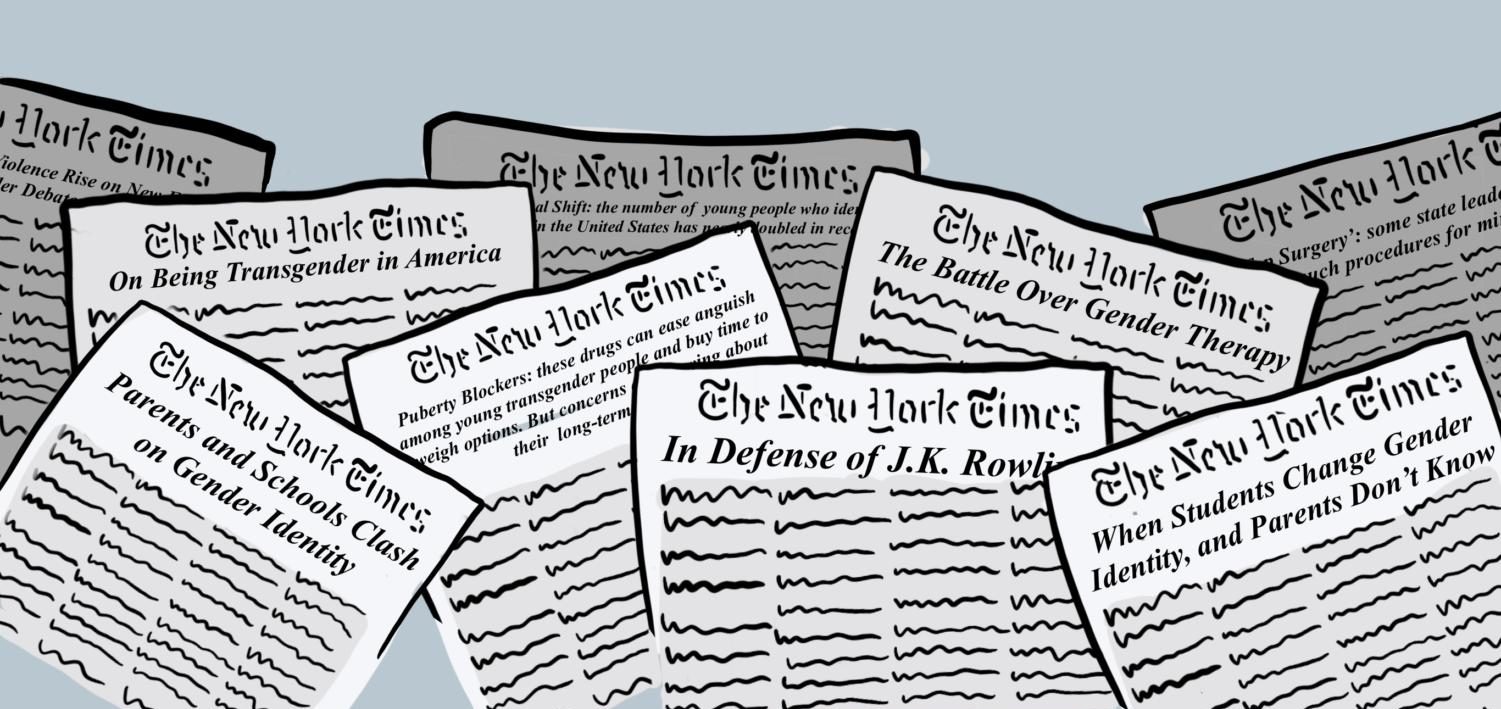Your donation will support the student journalists of the Evanstonian. We are planning a big trip to the Journalism Educators Association conference in Philadelphia in November 2023, and any support will go towards making that trip a reality. Contributions will appear as a charge from SNOSite. Donations are NOT tax-deductible.
Opinion | Framing the gender conversation
How the New York Times chose debate over normalizing trans-identities
April 20, 2023
Every Saturday, I pull out a shoebox from my bookshelf that has my HRT. I draw up my dose, swab my skin with rubbing alcohol, and give myself the weekly shot. This is not astronomical.
I walk downstairs, say hello to my dogs, and pull out my phone while pouring cereal for breakfast. I read through the news while eating rice crispies, often bombarded with news on the hateful anti-trans legislation sweeping our country—that is, unless I’m reading The New York Times.
I have always loved The New York Times. Raised by quintessential liberal parents, I learned to read through The Times and The Post, and have listened to NPR since before I could talk, with Ira Glass basically narrating my childhood. Yet, I have become less and less loyal to these media outlets as I have grown older, despite the fact that liberal media bias practically runs through my veins.
As of January 2023, it has been calculated that the NYT has run over 15,000 words in front page stories debating gender affirming care for youth. Times headlines such as “The Battle Over Gender Therapy” paint false narratives of what it truly means to be a trans kid, and are, not shockingly, pieces written by cisgender adults. Suddenly, it seemed like my childhood obsession with the Times had become a two way street, and I found myself wondering, ‘why is the NYT so weirdly obsessed with trans kids?’
The ACLU is currently tracking over 425 anti-LGBTQ bills in the U.S., ranging from civil rights to the right to use the bathroom. The number of states that have banned, or have considered banning, gender affirming care for minors is larger than the number of those with no introduced legislature, and these bills are spreading at a terrifying rate. Headlines about this legislation cover the front pages of the Washington Post, state newspapers and local publications. But what is the Times covering? “When Students Change Gender Identity, and Parents Don’t Know,” simultaneously creating a moral panic while trans kids are already being attacked by state governments.
It became increasingly dismaying to see not just op-ed columns, but all this coverage on the front page painting this sort of skeptical, fear mongering portrait of gender affirming care . . .
— NYT Contributer Sean T. Collins
I’m not the only one who noticed this problematic coverage. On February 15th, a group of NYT contributors sent out a letter to the editor describing their concerns with the publication’s coverage of trans issues. Contributor Sean T. Collins, a movie and television reviewer for the Times, served as a co-author of the letter, along with 7 other contributors who shared the same concern. The published letter was signed by over 1,200 NYT contributors, as well as 34,000 media workers, Times readers, and subscribers.
“It became increasingly dismaying to see not just op ed columns, but all this coverage on the front page painting this sort of skeptical, fear mongering portrait of gender affirming care for trans youth, in particular,” says Collins, in response to his initial involvement with the letter.
The response from the Times was dismissive, despite the fact that the contributors went through every correct avenue to publish the letter. The publication defended their coverage, even taking it so far to say they were doing a service to the LGBTQ+ community, which was followed by the disciplining of the contributors involved.
“They dismissed us repeatedly as activists,” says Collins, “which was bitterly ironic, given that at one point, they thought highly enough of all of us to pay us to write for them, or shoot for them or draw from them, or whatever the case was. I’m still writing for them.”
Then, on Feb. 16—just one day after receiving this letter—The Times published an opinion piece titled “In Defense of JK Rowling,” written by columnist Pamela Paul, who has also written trending stories such as “The Far Right and Far Left Agree on One Thing: Women Don’t Count,” and “What Liberals can learn from Ron Desantis,” which all include arguments that gender inclusive language is hurting women.
JK Rowling has been the face of the Trans Exclusionary Radical Feminist (TERF) movement since 2020, tweeting her disgust about an article using the term “people who menstruate,” rather than “women” to describe those who have periods. Gender-inclusive terminology aims for inclusivity, yet has been criticized by TERFS for its “exclusion of women.” Cisgender women.
Everyone was so quick to justify transphobia through this singular New York Times piece. It seemed revolutionary to so many, yet it was really just a slap in the face to trans people and the contributors who sent the letter.
Evanston is a safe haven for white liberals, the same people reading The Times, the same people whose views are constantly reaffirmed by the publication they trust and value the most, and the response to this op-ed made that evidently clear.
This isn’t taking place in a vacuum, the Times has a shameful history of homophobia, and a shameful history of refusing to cover the AIDS crisis and then covering it in a gross way.
— NYT Contributor Sean T. Collins
When the JK Rowling opinion piece came out, people in my own community started reaching out asking if I had read it. The people closest to me expressed that the way they felt about trans people and the author had finally been verbalized. That we could all no longer justify avoiding the work of Rowling. That my little sister no longer had a reason to have donated all of her Harry Potter books and merch, which she did when this all happened three years ago.
The exclusion of people within their own spaces is not a new practice, and is something that I have found to be very common within the Evanston community. Low income families are not included in conversations about affordable housing, disabled individuals are not included in conversations about accessibility, and underrepresented students are rarely involved in conversations about equity. It is the white liberals who are constantly starting conversations about people who aren’t in the room, and it is these voices that are amplified through publications such as The New York Times.
And yet, The New York Times doesn’t have a positive history surrounding coverage of LGBTQ+ issues. During the AIDS crisis, homophobic pieces were constantly being published, and the crisis itself did not have any front page coverage until almost 500 New Yorkers had already died.
“This isn’t taking place in a vacuum, the Times has a shameful history of homophobia, and a shameful history of refusing to cover the AIDS crisis and then covering it in a gross way, ” says Collins. “They published an op ed by William F. Buckley saying (AIDS) patients should be forcibly tattooed. That was in the New York Times, and they’re ashamed of this. They’ll be the first to tell you. And I think for all of us, we’re not going to sit around waiting another 20 years until the time to realize what they’re doing right now is also shameful. We’re going to point that out for them if they’re not able to see it for themselves. Because we are the New York Times, we’ve all written for them.”
As both a trans kid and student journalist, The New York Times has consistently disappointed, disgusted and offended me through their coverage of what they deem as trans issues. The golden rule and guiding principle of good journalism is to find the truth and report the truth, and it is increasingly dismaying to see the country’s top publication continue to veer further away from the truth, and closer to the ideas being spewed by anti-trans, radical conservative hate groups. In today’s society, it is more important than ever to tell everyone’s story, truthfully and authentically, and not through a distorted lens.
To the standard editors at the New York Times, listen to what your staff is placing directly in front of your face. Do not let history repeat itself any further.
To the contributors who wrote the letter, thank you. You are the journalists that I aspire to be.
And to you, reader, be conscious of the media you consume. Be constantly skeptical of headlines and news sources. Do not blindly support the systemic transphobia the Times is fueling. It is truly a matter of life or death for America’s trans youth.

